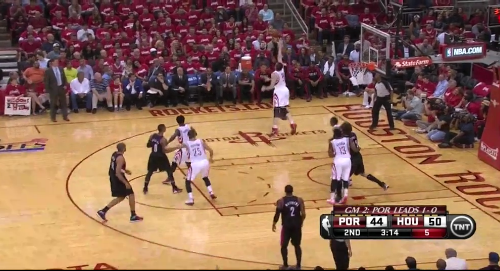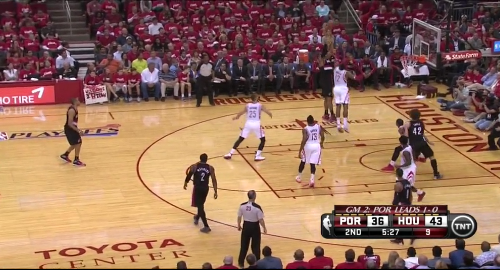An hour or so after Game 2’s final horn—after dust settled, blood dried, and small children stopped crying—Chandler Parsons stood in front of his locker, showered, dressed in clean clothes, all ready to explain the unexpected carnage the world had just witnessed on national television.
A few minutes into the scrum, a reporter asks Parsons about Portland’s sweet, soul-crushing big man, LaMarcus Aldridge. With lifeless eyes, Parsons scratches his beard and gives an answer:
…ain’t nobody in the world who can guard him one-on-one right now. You can’t even really knock Terrence, or Omer or Dwight’s defense because they’re playing him tough and contesting everything. There’s nothing much left to do besides just straight up double-teaming him to get the ball out of his hands and make their other guys beat us.
This wasn’t hyperbole. It wasn’t crazy. It wasn’t an excuse. Aldridge is out of this world right now, torturing one fan base while another dances on his shoulders. He has 89 points in 81 playoff minutes, shooting 59.3% from the floor with a 41.6 PER. Nobody has a higher True Shooting percentage or Offensive Rating. Nobody has more Win Shares. His shot chart resembles a well-manicured lawn.
Aldridge is just the third player to score at least 40 points in Games 1 and 2 on the road in NBA playoff history, joining Michael Jordan and Tracy McGrady. Furthermore: Only four other players in NBA history have scored at least 89 points in their first two games of a playoff season: Jordan (112 points in the 1986 playoffs and 105 in the 1988 playoffs), Jerry West (101 in the 1965 playoffs), Elgin Baylor (89 in the 1961 playoffs), and McGrady (89 in the 2003 playoffs). What Aldridge is doing happens about once every 20 years.
Which brings us to the million dollar question. How do the Houston Rockets stop him? Aldridge is a mid-range specialist. His sweet spot gives analytical NBA thinkers a migraine. If Omer Asik or Dwight Howard puts a knee in Aldridge’s behind and nudges him out to 18 feet, then gets a hand in his face to strongly contest an off balance jumper, there’s no shame if the ball goes in. This is good defense. But when this exact sequence happens roughly 19 possessions in a row, it’s time to try something else.
Here’s a look at how the Rockets guarded Aldridge in Game 2, and what they might want to try as the series heads to the Pacific Northwest. Let us first briefly talk about all the good Houston did. Aldridge scored 15 points with Asik guarding him, but shot “only” 53%, per SportVU. Asik bumped Aldridge, kept a hand in his face, and generally did a really good job pre and post-catch. Last night was just one of those times where a professional scorer is doing unforgettable things, and offense cant’ be tamed.
On some plays, it was physically impossible for Asik to play any better without fouling. Like this one below: Asik eclipses Aldridge’s entire body from the picture, but the shot still falls through the rim.
Watch how he makes Aldridge put the ball on the floor, then stays in front to force a difficult runner. It’s tremendous man-to-man defense.
And check out these contests from Howard:
Okay, so that just about sums up all the good stuff. Now onto the not so good. During Game 2, I’m sure millions of viewers were dumbfounded as to why the Rockets didn’t simply double Aldridge on the catch. Well, doubling essentially trades a contested long two for an open three, which isn’t ideal against a team featuring Damian Lillard, Wesley Matthews, Nicolas Batum, and the rest of Portland’s long-range snipers. It’s a really tough strategy to pull off. Kevin McHale demurred after the game about his team’s attempt to switch things up:
Tonight, [Aldridge] was picking and popping and moving and we were having a hard time running people at him because he was on the perimeter most of the time. We were trying to get the ball out of his hands as much as we could but a lot of the stuff he did was pick and pop.
This is mostly true. Aldridge went 6-for-8 as the roll man on pick-and-rolls, per mySynergySports. But Aldridge took 28 shots, leaving 20 attempts unaccounted for. Here are a few instances where Houston had plenty of time to race a second defender over and force a pass.
These were designed post-ups from the mid-range, plain and simple. The Rockets had opportunities to double with a perimeter player (James Harden haphazardly helped off his man about 6000 times during the regular season anyway!), but doing so would require weakside rotations out to the three-point line—something Houston struggled with all year long. If the Rockets continue to play Aldridge straight up in Game 3, it’s because McHale’s worried about getting shot out of the gym.
All that being said, the fact that no second defender rushed over to help out on this play is baffling. Terrence Jones can’t guard Aldridge, and shouldn’t spend another second on him in Game 3.
But not doubling was far from Houston’s biggest problem. They missed rotations, lacked communication, and showed no intensity crashing the glass. Aldridge was WIDE open—as in no Rockets were even in the beginning stages of a close out—on at least three jump shots. There’s no need in making the trip to Portland if this continues.
This is disturbing stuff. But why is it happening? What adjustments can the Rockets make? One of the easiest modifications can go to pick-and-roll defense. Howard and Asik spent most of the year dropping back on pick-and-rolls and playing a one-man zone around the free-throw line. Both are really good at it. But against point guards who can shoot (Lillard), McHale likes his guys to be more aggressive, showing or hedging on the perimeter before scampering back to proper position.
This strategy isn’t working right now. Howard in particular isn’t moving very well, and it’s allowing Lillard to pick Houston apart. Here’s one of Portland’s favorite plays: a Lillard-Aldridge side screen-and-roll, preceded by Matthews coming up to give Howard a little bump on his way to the three-point line.
Houston would love to guard this play with two guys, but Howard’s too slow recovering back to Aldridge. Jones is then supposed to slide across the lane and assume responsibility as a help defender, but he doesn’t realize it until the shot is already on its way to becoming two easy points.
Portland runs the same play moments later (with Batum and Matthews swapping position), and Lillard again easily gets around Howard. This time, Jones is ready and anticipates a pass to Aldridge. Lillard recognizes Houston’s adjustment and calmly rifles a pass to Robin Lopez (Jones’ man), who misses the bunny. Howard flies in for the rebound, but it ends up in Aldridge’s hands for an easy put back.
Overall, Houston defended this play pretty well, but in Game 3, the adjustment needs to come as soon as Lopez releases his shot. All five Rockets need to crash the glass here; defending the three-point line is key, but plays like this one are vital. Houston can’t let Aldridge’s points ever be this easy, so Patrick Beverley, Harden, and Parsons all need to get physical and put a body on someone.
Defensive rebounds fuel Houston’s transition attack. They’re important. But so is Howard’s defense. Here’s the most glaring example.
Look how Lillard eases his way around the big man, gets all the way into the paint, and hits a rolling Aldridge for one of his easiest baskets of the night. Why not try a more conservative strategy and force Portland to attack in a different way?
Here’s another play Portland loves to run. It begins as a hand off/screen on one side of the floor before turning into a pick-and-roll on the other.
Again, Howard extends himself and Aldridge catches the ball wide open in the middle of the floor. Not good. Jones does a good job reading the play and coming out to contest, but Aldridge still ends up with an open shot. The energy Howard exerts doing all that running here is appreciated but unnecessary. Here’s the exact same play a few minutes later.
Notice anything different? Instead of hedging, Howard stays put at the elbow. When Aldridge catches the pass, all Howard has to do is slide across the paint to pick him up. Portland’s spacing is jumbled up on this possession, and it’s no coincidence Aldridge badly misses the shot.
So, to recap: what should Houston do in Game 3? First, Howard and Asik need to guard Aldridge at all times. Harden, Parsons, and Jones have no business wasting even one possession trying to stop something they couldn’t hope to contain in a dream.
(A quick aside before moving on: Don’t be surprised if McHale unleashes Donatas Motiejunas on Aldridge for short spots during Game 3. He’s a seven-footer with length, speed, and athleticism, and he’s actually quite comfortable defending guys in open space. It’s not Plan A, but also couldn’t hurt.)
Second, Houston’s pick-and-roll coverage needs to change. If Howard and Asik continue to show and hedge that’s…fine, but only as long as everyone else supports them with perfect help rotations. Those aren’t likely on a team featuring Harden, Parsons, and Jeremy Lin. Houston should experiment with a little bit of everything on defense, including switching pick-and-rolls (only with Howard, even though he’s been slow of foot lately) and reverting back to the conservative “drop down” approach that helped make this a top-10 defense all year long.
Aldridge is playing out of his mind right now. Some of his shots are truly unstoppable, and those are the ones you live with. But Houston had a hand in making Aldridge’s life look easy through the first two games. They’ll need to execute solid adjustments over the next two contests, or a season that once had hope will meet a certain harsh ending.
Michael Pina covers the NBA for Sports on Earth, ESPN’s TrueHoop Network, FOX Sports, Grantland, Bleacher Report and The Classical. His writing can be found here. Follow him @MichaelVPina.
View this discussion from the forum.








